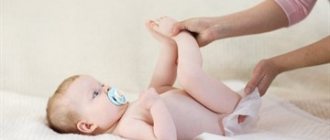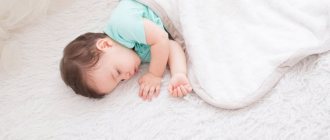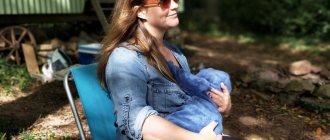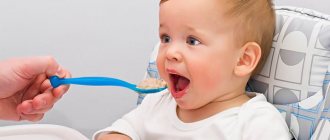Normal sleep in babies and children
Sleep is an opportunity for the body to conserve energy, restore normal processes, and promote physical growth and mental development. The most obvious consequence of insufficient sleep is daytime sleepiness. However, sleepiness in children also commonly manifests as irritability, behavioral problems, learning difficulties, and poor academic performance. Distinguishing significant sleep disturbances from normal age-related changes can be quite a diagnostic challenge.
Sleep changes significantly during the first few years of a child's life, following physical maturation and development. Newborns require the most total sleep time and have a fragmented sleep-wake schedule. From the age of five months, babies can sleep longer. By the age of six months, babies can go without night feedings. In addition, infants experience more frequent night awakenings, shorter sleep periods, and slightly less total sleep time. As children grow older, sleep periods gradually lengthen and total sleep time decreases.
The wide variation in children's sleep behavior may be secondary to cultural or genetic differences. Knowing the normal stages of sleep development can help clinicians and parents differentiate normal sleep from common sleep disorders such as obstructive sleep apnea, parasomnias, behavioral insomnia, sleep phase disorder, and restless leg syndrome.
Obstructive sleep apnea
Obstructive apnea is characterized by obstruction of the upper airway despite respiratory effort, which interferes with normal sleep patterns and pulmonary ventilation. The disease may be associated with obesity, a decrease in the size of the upper airway, or insufficiency of the pharyngeal dilator muscles. However, in children, obstruction occurs primarily due to enlarged tonsils and adenoids. Initial manifestations usually occur between the ages of two and eight years, which coincides with the peak growth of the tonsils, but the condition can appear at any age. The overall prevalence in children is between 1% and 5%. Both boys and girls suffer from sleep apnea, but the condition is more common in ethnic minorities. Classic symptoms of apnea are snoring and breathing problems. However, not all children who snore have this condition. The prevalence of nighttime snoring in children is as high as 27%, which can make apnea difficult to recognize. Other common symptoms include unusual sleeping positions (eg, hyperextended neck, sleeping with the mouth open), sleep-related paradoxical breathing, night sweats or enuresis, morning headaches, and excessive daytime sleepiness. However, children are less likely than adults to experience daytime sleepiness. Sleepiness in children most often manifests itself as depressed mood, poor concentration, decreased attention, or behavioral problems. Physical examination may reveal enlarged tonsils, micrognathia, and pectus excavatum.
Children with suspected obstructive sleep apnea should be referred for polysomnography. In addition, a referral to a sleep specialist will be needed for children at risk who suffer from attention deficit hyperactivity disorder, cardiorespiratory insufficiency, cranial anomalies, congenital defects and Down syndrome.
Left unchecked, apnea can lead to neurobehavioral problems, decreased attention, emotional dysregulation, decreased academic performance, nocturnal enuresis, growth disorders, and, in rare cases, systemic hypertension, pulmonary hypertension, and cor pulmonale.
The main treatment method is adenotonsillectomy. Postoperative polysomnography demonstrates relief from apnea in more than 70% of normal-weight children and in less than half of obese children. Postoperative improvements in quality of life and behavior may also occur. After treatment, all children should undergo a clinical examination six to eight weeks after surgery, and polysomnography should be repeated to assess residual apnea in obese children. 18 When prescribed, polysomnography should be performed after the pharynx has completely healed, usually no earlier than six weeks after surgery.
Possible causes of changes in a baby's biorhythm
The problem can arise on its own. It can be affected by both the baby’s poor health and an incorrect daily routine organized by adults. The main causes of confusion can be considered:
- Poor conditions for normal sleep. Parents often ignore recommendations about maintaining a healthy microclimate in the room where the baby sleeps. If the air is dry or too humid, and its temperature exceeds 18-20 °C, then the child will feel uncomfortable sleeping in such a room. Mom and dad should do everything possible to normalize these indicators. You can clean and humidify the air using a humidifier. The temperature is regulated either by an air conditioner or a special tap on the heating radiator.
- Pain and feeling unwell. The reasons that a newborn baby has confused day with night and sleeps poorly may be colic, elevated body temperature, or pain during teething. All these conditions are typical for babies of one month of age.
- Uncomfortable clothes. Sleep may be disturbed due to poor-quality clothing that has rough internal seams, as well as due to heavy swaddling. A newborn should be dressed in cotton clothes that do not irritate the skin, do not cause itching and overheating.
- Low daytime activity. If the baby is not busy with anything during the daytime, but constantly lies in the crib, then he does not waste energy and begins to spend it at night.
- Long daytime sleep. Almost all newborn babies sleep during the day, and their sleep duration is usually controlled by their parents. Pediatricians advise not to let your baby sleep too long during the day, otherwise he will sleep enough and not want to fall asleep at night.
- Emotional tension and excitement in the evening hours. To prevent overstimulation of the baby’s psyche in the evening, it is not recommended to play active games with him, invite guests home, or listen to loud dynamic music.
Parasomnias
Parasomnias such as sleepwalking (somnambulism), talking in sleep, confused arousal, horror and nightmares in sleep occur in every second child. They are defined as unwanted events that accompany sleep and usually occur during the transitions from sleep to wakefulness. In addition, they are characterized by the child's complex activities that appear goal-directed but are characterized by a lack of interaction with others around them. Associated features include confusion, automatic behavior, difficulty waking up, amnesia, and rapid return to full sleep after the event.
Most parasomnias, such as sleepwalking, sleep talking, confusional arousal, and sleep fears, occur in the first half of the sleep period during non-REM sleep. Children usually do not remember such an event. In contrast, nightmares usually occur in the second half of the sleep period during rapid eye movement sleep. Children can remember these events. It is important to note that the symptoms and timing of nocturnal seizures can coincide with parasomnias. These disorders may be indicated by repetitive, stereotypical behavior and strange sleep positions adopted by the child.
Precipitating factors include insufficient sleep and disorders that cause partial awakening from sleep. Apnea is a common trigger for parasomnia: more than half of children presenting for sleep terrors or sleepwalking also have apnea. Other triggers may include restless legs disorder, gastroesophageal reflux disease, forced awakenings, and certain medications.
Parasomnias often resolve spontaneously by adolescence. Treatment focuses on calming, reducing triggers, and increasing total sleep time. When appropriate, parents should be informed of safety precautions (eg, lock doors and windows, use motion alarms, clear the floor of toys, place a mattress on the floor). Children who exhibit atypical, disruptive, or aggressive behavior or who do not respond to conservative treatments should be referred to a mental health professional for further evaluation.
Still have questions?
Get an online consultation from leading pediatricians in St. Petersburg!
A professional and experienced pediatrician will answer your questions.
Medical care for a child without leaving home at a convenient time.
sign up for a consultation
A Skype consultation lasts 45 minutes.
Behavioral insomnia in childhood
Behavioral insomnia in childhood is characterized by a learned inability to fall asleep and/or stay asleep. The prevalence of pathology ranges from 10% to 30%. Some disorders are characterized by the child's inability or unwillingness to fall asleep or return to sleep in the absence of certain conditions, such as a soothing parent (sleep association disorder). The no-restrictions option occurs when parents fail to set appropriate boundaries, such as when parents allow the child to sleep in their own bed when the child refuses to sleep. Most children with behavioral insomnia exhibit traits of both types during childhood.
Prevention is the best treatment for behavioral insomnia in childhood. Clinicians should teach parents about normal sleep patterns, good sleep hygiene, realistic expectations, setting boundaries, and bedtime routines. These actions should focus on feeding your baby regularly and consistently, maintaining bedtimes, bedtime routines, and bedtimes. Babies are more likely to suck on a pacifier and fall asleep on their own if they are constantly placed in their crib awake rather than already asleep. Creating a regular routine will set expectations and eventually your baby will learn to fall asleep on his own. Ignoring techniques (putting the child to bed and ignoring him until the morning or for a certain period) are also effective in treating this disorder. Sleeping pills and sedatives are ineffective for treating this disorder.
What is the danger of an “inverted” sleep pattern?
We hasten to reassure you right away: for a small child such a violation of the regime is not dangerous, which cannot be said about his parents. Not only do they at some point risk being left completely exhausted from lack of sleep. There is another danger. If dad is given the opportunity to sleep in another room, and mom makes up for the lack of sleep during the day with the baby, then dad, of course, will get enough sleep, but then the relationship between the parents may experience tension due to such a discrepancy in modes. Not to mention the fact that housework must also be done somehow.[3]
What determines a child's desire to sleep?
- From a lot of factors. However, three fundamental ones stand out:
- energy consumption during the day;
- features of the previous sleep (quality, duration, how long ago it was);
- meal (after a hearty lunch you always want to take a nap).[4]
How to overcome the problem of day and night confusion?
- To rule out health problems, consult your pediatrician.
- Analysis of the situation. Try to reconstruct what preceded the first sleepless night.
- Check the conditions in which the child sleeps (freshness and coolness of the air in his room, comfort of the bed, linen and pajamas).
- Be decisive and unwavering. You will have to hide your pity and try to make sure that your baby does not get enough sleep during the day. It is tedious to remove one of the daytime dreams without prolonging the others![5]
- Provide your child with optimal energy expenditure commensurate with his age and psyche during the day (walks, games, gymnastics), leaving the quietest hours for the time before bedtime.
- Don’t bundle up your baby, dress him comfortably and according to the season.
- Adjust your eating schedule. Before going to bed at night, you need to feed your child well, but at 6 pm you can underfeed a little. Remember that after eating comes the sweetest dream, and Morpheus is not in a hurry to come to us on an empty stomach.
- Before the last feeding, arrange water procedures in water at a comfortable temperature.[6]
Remember, dear parents, a successful resolution of the situation is only in your hands! The main thing is calm, only calm!
Delayed sleep phase disorder
The master circadian clock, located in the suprachiasmatic nucleus, controls sleep time and operates on a 24-hour cycle for most people. The discrepancy between the internal clock and the external world requires constant “resetting” by temporal cues such as light, melatonin, physical activity, body temperature and food intake. Light is the most powerful of these pointers - synchronizers. Inappropriate timing of light exposure can alter circadian rhythms. For example, exposure to light before bed (especially blue light from TV screens) can suppress melatonin production and ultimately delay sleep onset. Children with delayed sleep phase disorder experience normal bedtimes and wake times that are at least two hours behind socially acceptable times. The disorder is more common during adolescence, when the circadian rhythm is thought to lengthen and the child becomes more social. The prevalence of the disorder among adolescents ranges from 7% to 16%. The condition is diagnosed based on the patient's medical history and documenting sleep and wake times in a diary or sleep log. Parental concerns typically relate to late bedtimes (2 a.m. or later), sleeping in, difficulty waking up, and being late for school. However, frequent night awakenings are unusual and sleep architecture is usually normal.
Treatment aims to align the circadian rhythm with desired sleep and wake times. As with all sleep disorders, maintaining a regular sleep-wake cycle and good sleep hygiene are the cornerstones of treatment. It is important to avoid bright light before bed. Removing all light-emitting devices (eg, electronics, portable media, tablet computers, cell phones) from the bedroom may be helpful. Bright light therapy used within the first one to two hours of waking up may also be helpful in improving circadian rhythm. There is good evidence that melatonin supplementation (0.3 to 5 mg 1.5 to 6.5 hours before desired bedtime) is an effective treatment for delayed sleep phase disorder.
Conclusion
By following simple rules of sleep hygiene, they provide the child and parents with comfortable conditions for a good night's rest. In order not to encounter a situation of confused day and night, make sure that the child sleeps for a relatively short time during the day and eats heavily at night, but not excessively. It is equally important to monitor the quality of sleepwear, cribs, and indoor microclimate. To avoid problems with the rhythm or eradicate existing ones, introduce a daily routine, perform daily rituals of preparation for sleep, including ablution, lullaby, massage.
Restless legs syndrome
The incidence of restless legs syndrome in children is about 2%. The condition is characterized by an unpleasant sensation in the legs with an urge to move the legs, starting in the evening. Rest worsens symptoms, but movement provides some relief. Other symptoms include difficulty falling asleep, bedtime resistance, growing pains, and symptoms similar to those of attention deficit hyperactivity disorder. The disease in children is associated with negative behavior and mood, decreased cognitive abilities and attention, and is more common in children with attention deficit hyperactivity disorder. Dopamine dysfunction and iron deficiency are thought to play a major role in the pathogenesis of restless leg syndrome. In addition, symptoms may be aggravated by excessive or insufficient physical activity or the use of caffeine, nicotine, antihistamines, selective serotonin reuptake inhibitors, or tricyclic antidepressants.
Diagnosing restless legs syndrome in children can be challenging because they may not be able to describe the main symptoms. The diagnosis can be made if the history is appropriate and at least two of the following are present: sleep disturbance, the disorder in a first-degree relative, or five or more periodic limb movements per hour of sleep during polysomnography.
Once restless leg syndrome is diagnosed, conservative treatment involves avoiding aggravating factors. Because iron deficiency is common in these children, measurement of ferritin levels is necessary. Iron replenishment therapy should be started if ferritin levels are less than 50 mcg/liter. There are no medications approved to treat restless legs syndrome in children. Patients with symptoms that do not respond to conservative treatment should be referred to a mental health professional for further evaluation.
Call a doctor at home Make an appointment with a doctor or call +7 (812) 331-17-74











